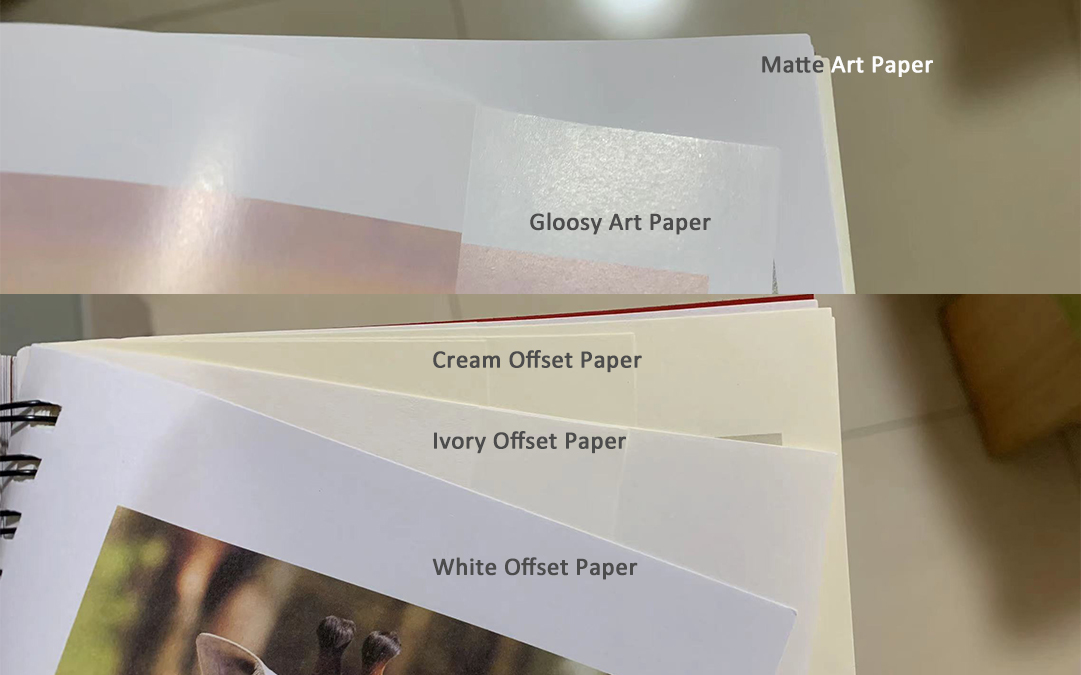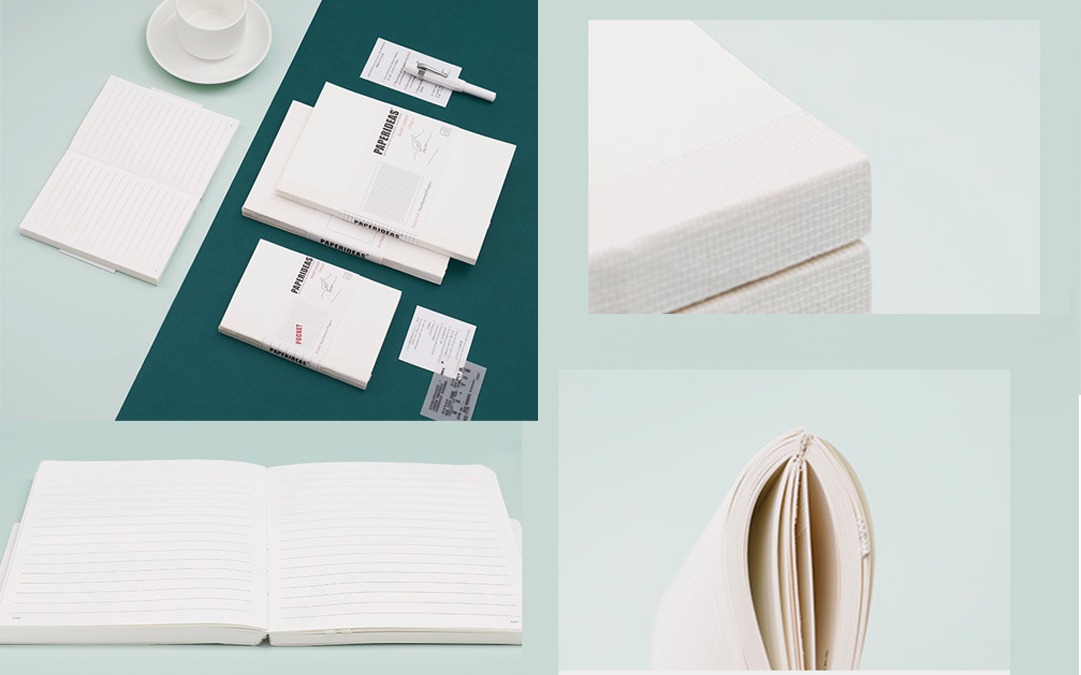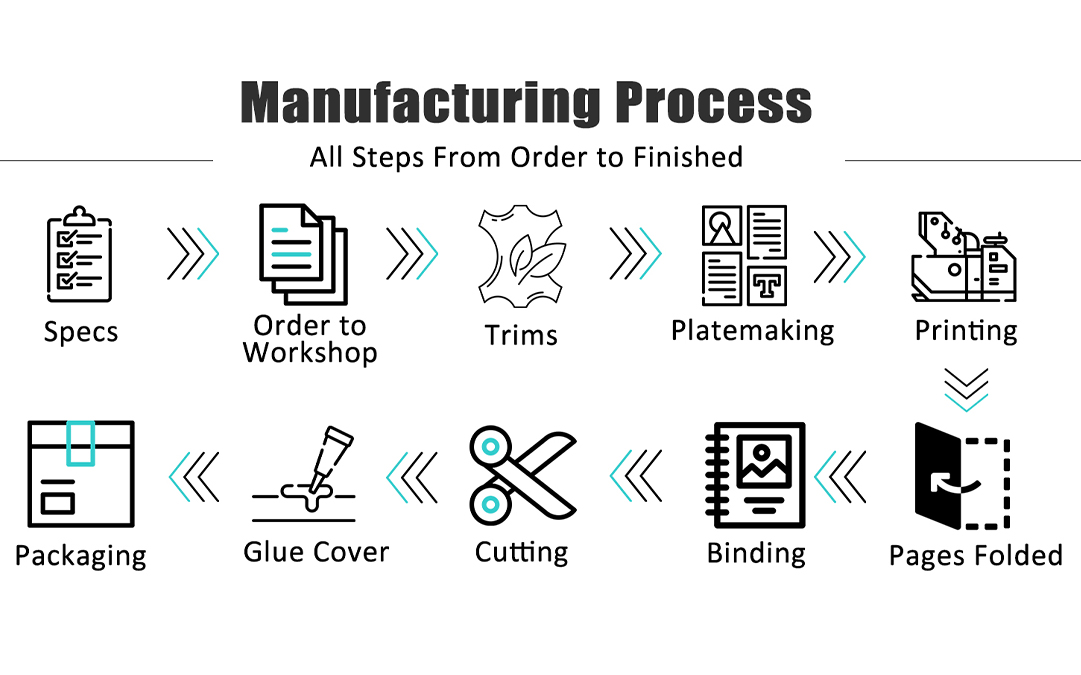Comprehensive Guide to Notebook Printing Paper Options
When selecting paper for notebook printing, choosing the right type can make a significant difference in the final product’s quality and usability. Here’s a detailed look into the various paper options available for notebook printing, including their characteristics and best use cases.
1. Commonly Used Paper Types
Offset Paper (Wood-Free Paper)
- Characteristics: Smooth writing surface.
- Grammage Options: 80gsm, 100gsm, 120gsm (thicker options like 140gsm can be used for paper cards).
- Color Options:
- Ivory: Popular for its eye protection benefits, especially for children and students.
- Cream: Slightly yellower than ivory, offering a warmer tone.
- White: Similar to standard office A4 paper, available based on preference.
Other Options:
- Acid-Free Paper: Long-lasting and durable, suitable for archival purposes.
- Stone Paper: Eco-friendly and water-resistant, ideal for specific niche markets.
2. Specialized Paper for Different Applications
Textbook, Coloring Book, Novel, Children’s Book, Letter Paper
- Coloring Book Paper: Typically uses 120gsm or 140gsm for better ink resistance and durability during drawing.
Art Paper (Coated Paper / Matte Coated Paper)
- Characteristics: Displays vibrant colors with offset printing, ideal for detailed color patterns.
- Common Uses: Children’s books, company catalogs, magazines, and planner tabs.
- Grammage Options: 128gsm, 157gsm, 200gsm, 250gsm, 300gsm, 350gsm.
3. Specialty Papers
C1S Paper (One-Side Coated Paper)
- Characteristics: Coated on one side, uncoated on the other, providing a good balance for single-side color printing with enhanced effects.
- Common Uses: Cards, book covers, folders.
- Grammage Options: 200gsm, 250gsm, 300gsm, 350gsm.
Fancy Card Paper
- Applications: Business cards, folders, and other high-quality print items.
4. Paper Thickness and Weight Correspondence
Understanding the relationship between paper weight (gsm) and thickness (mm) is crucial for selecting the right paper. Here’s a quick reference table:
| Paper Gram and Thickness Corresponding Table | |||||
| Offset Paper | Art Paper / Coated Paper / C2S |
Matte Art Paper / Uncoated Paper |
|||
| Gram Weight / gsm |
Thickness / mm |
Gram Weight / gsm |
Thickness / mm |
Gram Weight / gsm |
Thickness / mm |
| 80 | 0.095 | 80 | 0.06 | 105 | 0.09-0.1 |
| 100 | 0.11 | 105 | 0.08 | 128 | 0.12-0.13 |
| 120 | 0.14 | 128 | 0.1 | 157 | 0.16 |
| 150 | 0.17 | 157 | 0.12 | 200 | 0.19-0.2 |
| 180 | 0.2 | 200 | 0.17 | 250 | 0.25 |
| 200 | 0.23 | 210 | 0.21 | 300 | 0.31 |
| 250 | 0.29 | 230 | 0.25 | ||
| 300 | 0.33 | 250 | 0.265 | ||
| 350 | 0.4 | 300 | 0.35 | ||
| 400 | 0.47 | 350 | 0.41 | ||
| 400 | 0.465 | ||||
| White Board Paper / C1S Paper |
Duplex Board / CCNB | ||||
| Gram Weight / gsm |
Thickness / mm |
Gram Weight / gsm |
Thickness / mm |
||
| 210 | 0.27 | 250 | 0.32 | ||
| 230 | 0.3-0.31 | 300 | 0.37 | ||
| 250 | 0.33 | 350 | 0.44-0.45 | ||
| 300 | 0.4-0.41 | 400 | 0.49 | ||
| 350 | 0.47-0.48 | ||||
| 400 | 0.55 | ||||
| Paper PT and Gram Weight Corresponding Table | |||||
| C2S Paper | C1S Paper | ||||
| PT | Standard Gram Weight / gsm | Used Gram Weight / gsm | PT | Standard Gram Weight / gsm | Used Gram Weight / gsm |
| 7PT | 182 | 7PT | 161 | ||
| 8PT | 195 | 8PT | 174 | 190 | |
| 9PT | 225 | 230 | 9PT | 199 | 210 |
| 10PT | 234 | 230 | 10PT | 225 | 230 |
| 12PT | 270 | 300 | 12PT | 236 | 250 |
| 14PT | 306 | 300 | 14PT | 265 | 300 |
| 16PT | 340 | 350 | 15PT | 280 | 300 |
| 18PT | 358 | 350 | 16PT | 296 | 300 |
| 20PT | 420 | 400 | 18PT | 324 | 350 |
| 24PT | 230gsm C1S Mounted | 20PT | 345 | 350 | |
| 30PT | 300gsm C1S Mounted | 22PT | 379 | 400 | |
| 24PT | 407 | 400 | |||
| 26PT | 435 | 450 | |||
Offset Paper:
| Gram Weight (gsm) | Thickness (mm) |
|---|---|
| 80 | 0.095 |
| 100 | 0.11 |
| 120 | 0.14 |
| 150 | 0.17 |
| 180 | 0.2 |
| 200 | 0.23 |
| 250 | 0.29 |
| 300 | 0.33 |
| 350 | 0.4 |
| 400 | 0.47 |
Art Paper (Coated Paper / C2S):
| Gram Weight (gsm) | Thickness (mm) |
|---|---|
| 80 | 0.06 |
| 105 | 0.08 |
| 128 | 0.1 |
| 157 | 0.12 |
| 200 | 0.17 |
| 210 | 0.21 |
| 230 | 0.25 |
| 250 | 0.265 |
| 300 | 0.35 |
| 350 | 0.41 |
Matte Art Paper (Uncoated Paper):
| Gram Weight (gsm) | Thickness (mm) |
|---|---|
| 105 | 0.09-0.1 |
| 128 | 0.12-0.13 |
| 157 | 0.16 |
| 200 | 0.19-0.2 |
| 250 | 0.25 |
| 300 | 0.31 |
5. C1S Paper and Duplex Board Options
White Board Paper / C1S Paper:
| Gram Weight (gsm) | Thickness (mm) |
|---|---|
| 210 | 0.27 |
| 230 | 0.3-0.31 |
| 250 | 0.33 |
| 300 | 0.4-0.41 |
| 350 | 0.47-0.48 |
| 400 | 0.55 |
Duplex Board / CCNB:
| Gram Weight (gsm) | Thickness (mm) |
|---|---|
| 250 | 0.32 |
| 300 | 0.37 |
| 350 | 0.44-0.45 |
| 400 | 0.49 |
6. Paper PT and Gram Weight Correspondence
C2S Paper:
| PT | Standard Gram Weight (gsm) | Used Gram Weight (gsm) |
|---|---|---|
| 7PT | 182 | 200 |
| 8PT | 195 | 200 |
| 9PT | 225 | 250 |
| 10PT | 234 | 250 |
| 12PT | 270 | 300 |
| 14PT | 306 | 300 |
| 16PT | 340 | 350 |
| 18PT | 358 | 350 |
| 20PT | 420 | 400 |
| 24PT | 230gsm C1S Mounted | |
| 30PT | 300gsm C1S Mounted |
C1S Paper:
| PT | Standard Gram Weight (gsm) | Used Gram Weight (gsm) |
|---|---|---|
| 7PT | 161 | |
| 8PT | 174 | 190 |
| 9PT | 199 | 210 |
| 10PT | 225 | 230 |
| 12PT | 236 | 250 |
| 14PT | 265 | 300 |
| 15PT | 280 | 300 |
| 16PT | 296 | 300 |
| 18PT | 324 | 350 |
| 20PT | 345 | 350 |
| 22PT | 379 | 400 |
| 24PT | 407 | 400 |
| 26PT | 435 | 450 |
By understanding these paper options and their specific uses, you can ensure that your custom notebooks meet the desired quality and functionality for your customers. This detailed knowledge allows you to make informed decisions, leading to better satisfaction and enhanced product appeal.
Contact Us: Ms. Rimo Lau WhatsApp Me
Whatsapp: 0086 18336352791 – WeChat&Phone
Website: www.fullcolorprintstationery.com
E-Mail: [email protected]





